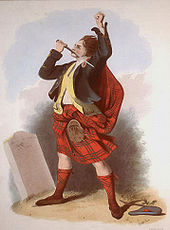Aulay MacAulay of Ardincaple
Sir Aulay MacAulay of Ardincaple (died 1617) was a Scottish laird, knight, clan chief, and a shire commissioner.
The MacAulay estate of Ardincaple was situated in the location of the modern village of Rhu and Helensburgh, which both lie on the eastern shore of the Gare Loch, in Argyll and Bute.
[1] According to the 19th-century historian Joseph Irving, Walter and his elder half-brother, Alexander, were likely the first of the clan to take the surname MacAulay.
[5][note 1] In the 15th and 16th centuries, the 'native' clans of the Lennox—the MacAulays, MacFarlanes, and Colquhouns—raided and plundered each other's lands and combined to sweep the lowlands of its flocks and herds.
The giving of calp—a tribute of cattle or the best eighth of a part of goods to a superior lord or chief—was a significant custom in Gaelic society.
[10][11] According to historian Ronald Williams, the contract between Ardincaple and Glenstrae gave the MacGregors some temporary relief from the Buchanans and Galbraiths.
The MacAulays and Colquhouns feared that it was much more likely that the Galbraiths, allied with the Buchanans, would direct their vengeance against themselves under the guise of hunting and clearing Clan Gregor from the Lennox.
[9][14] Due to the influence of the Ardincaple's superior, Ludovic Stewart, 2nd Duke of Lennox, the letters of Fire and Sword were taken from the Galbraiths and Buchanans.
According to Williams, Ardincaple had been sparing of the entire truth, for no mention was made of the bond of manrent between himself and the now outlawed Clan Gregor chief.
The evidence pointed to Carrick's men coming at night to Ardincaple and attacking followers of the laird and killing one—Malcolm Galbraith.
At the end of November 1600, Carrick and 100 followers invaded the lands of Ardincaple armed with "hagbuts, pistolets, bows, darlochs and habershons".
Carrick's force, for fear of being pursued by men of the district, left the area after destroying houses, hamstringing animals, and making off with livestock belonging to other tenants of the duke.
In the process the Carrick men "spuilyeit the houssis of John Dow McAula in Garelocheid and Patrik McCaula in Aldonit".
By an Act of the Privy Council, on 3 April 1603, it was made an offence to bear the name MacGregor, or to give add and shelter to one.
The Earl of Argyll, who was responsible to the Privy Council for the actions of the MacGregors, was entrusted to bring the force of the law against this lawless clan.
[21] On 7 April 1603, James VI wrote from Berwick to the Justice General and his deputies, declaring Ardincaple to be innocent of the alleged crimes and that he was to accompany the king to England with the Duke of Lennox.
[23] Within his 'confession', Glenstrae accused Argyll of trying to persuade him to kill Ardincaple: "I Confess, before God, that he did all his craftie diligence to intyse me to slay and destroy the Laird Ardinkaippill, Mckallay, for ony ganes kyndness or freindschip that he mycht do or gif me.
[3] The 19th-century historian William Anderson stated that Ardincaple probably intended to avert suspicions upon himself, for his prior dealings with the clan.



